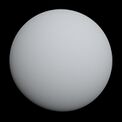Astronomy:HD 180902 b
| Discovery[1] | |
|---|---|
| Discovered by | Johnson et al. |
| Discovery site | Keck Observatory |
| Discovery date | 2010 |
| Doppler spectroscopy | |
| Orbital characteristics[2] | |
| 1.40±0.11 astronomical unit|AU | |
| Eccentricity | 0.107±0.022 |
| Orbital period | 510.9±1.5 d |
| |{{{apsis}}}|helion}} | 2455055±17 JD |
| 181±12 º | |
| Semi-amplitude | 34.25±0.84 m/s |
| Star | HD 180902 |
| Physical characteristics[2] | |
| Mean radius | 1.221 RJ |
| Mass | ≥1.685±0.041 Jupiter mass |
HD 180902 b is an extrasolar planet orbiting the K-type star HD 180902 approximately 342 light years away[3] in the constellation Sagittarius.[1]
Discovery
HD 180902 b, along with other planets, was discovered in 2010 by scientists at the Keck Observatory. These planets were discovered via doppler spectroscopy, which is detecting exoplanets using the star's wobble.
Properties
Orbit
HD 180902 b takes 510 days to orbit its parent star, which is longer than Earth's orbital period, which is 365 days. It orbits at a distance similar to Earth from the sun. HD 180902 orbits with mild eccentricity.
Characteristics
HD 180902 b has a minimum mass of 1.685 times the mass of Jupiter, but since its inclination is not known, the true mass of the planet cannot be detected. According to a theoretical search by the observatory, it may have a radius that is 22.1% larger than Jupiter.
See also
References
- ↑ Jump up to: 1.0 1.1 Johnson, John Asher et al. (2010). "Retired a Stars and Their Companions. IV. Seven Jovian Exoplanets from Keck Observatory". Publications of the Astronomical Society of the Pacific 122 (892): 701–711. doi:10.1086/653809. Bibcode: 2010PASP..122..701J.
- ↑ Jump up to: 2.0 2.1 Luhn, Jacob K. et al. (2019). "Retired A Stars and Their Companions. VIII. 15 New Planetary Signals around Subgiants and Transit Parameters for California Planet Search Planets with Subgiant Hosts". The Astronomical Journal 157 (4): 149. doi:10.3847/1538-3881/aaf5d0. Bibcode: 2019AJ....157..149L.
- ↑ Brown, A. G. A. (August 2018). "Gaia Data Release 2: Summary of the contents and survey properties". Astronomy & Astrophysics 616: A1. doi:10.1051/0004-6361/201833051. Bibcode: 2018A&A...616A...1G. Gaia DR2 record for this source at VizieR.
External links
- "HD 180902 b". Extrasolar Planets Encyclopaedia. 1995. https://exoplanet.eu/catalog/hd_180902_b--657/.
Coordinates: ![]() 19h 19m 18s, −23° 33′ 29″
19h 19m 18s, −23° 33′ 29″
 |



